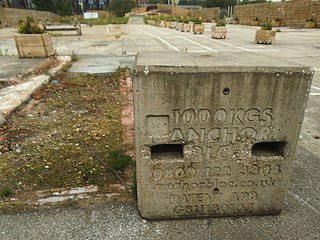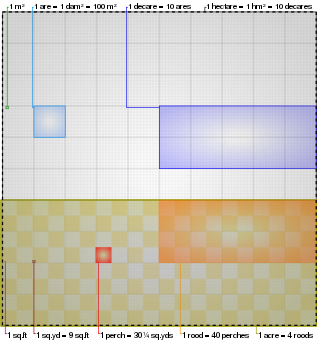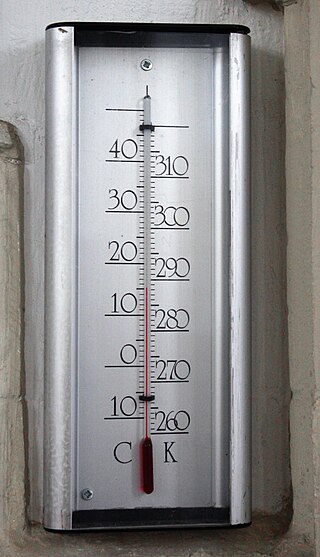
The ampere, often shortened to amp, is the unit of electric current in the International System of Units (SI). One ampere is equal to 1 coulomb (C) moving past a point per second. It is named after French mathematician and physicist André-Marie Ampère (1775–1836), considered the father of electromagnetism along with Danish physicist Hans Christian Ørsted.

A centimetre or centimeter is a unit of length in the International System of Units (SI) equal to one hundredth of a metre, centi being the SI prefix for a factor of 1/100. Equivalently, there are 100 centimetres in 1 metre. The centimetre was the base unit of length in the now deprecated centimetre–gram–second (CGS) system of units.

The kilogram is the base unit of mass in the International System of Units (SI), having the unit symbol kg. It is a widely used measure in science, engineering and commerce worldwide, and is often simply called a kilo colloquially. It means 'one thousand grams'.

The litre or liter is a metric unit of volume. It is equal to 1 cubic decimetre (dm3), 1000 cubic centimetres (cm3) or 0.001 cubic metres (m3). A cubic decimetre occupies a volume of 10 cm × 10 cm × 10 cm and is thus equal to one-thousandth of a cubic metre.
Mega is a unit prefix in metric systems of units denoting a factor of one million (106 or 1000000). It has the unit symbol M. It was confirmed for use in the International System of Units (SI) in 1960. Mega comes from Ancient Greek: μέγας, romanized: mégas, lit. 'great'.

The micrometre as used by the International Bureau of Weights and Measures; SI symbol: μm) or micrometer, also commonly known by the non-SI term micron, is a unit of length in the International System of Units (SI) equalling 1×10−6 metre ; that is, one millionth of a metre.

The International System of Units, internationally known by the abbreviation SI, is the modern form of the metric system and the world's most widely used system of measurement. Coordinated by the International Bureau of Weights and Measures it is the only system of measurement with an official status in nearly every country in the world, employed in science, technology, industry, and everyday commerce.
A metric prefix is a unit prefix that precedes a basic unit of measure to indicate a multiple or submultiple of the unit. All metric prefixes used today are decadic. Each prefix has a unique symbol that is prepended to any unit symbol. The prefix kilo-, for example, may be added to gram to indicate multiplication by one thousand: one kilogram is equal to one thousand grams. The prefix milli-, likewise, may be added to metre to indicate division by one thousand; one millimetre is equal to one thousandth of a metre.

The tonne is a unit of mass equal to 1,000 kilograms. It is a non-SI unit accepted for use with SI. It is also referred to as a metric ton in the United States to distinguish it from the non-metric units of the short ton and the long ton. It is equivalent to approximately 2,204.6 pounds, 1.102 short tons, and 0.984 long tons. The official SI unit is the megagram (Mg), a less common way to express the same amount.

The metric system is a decimal-based system of measurement. The current international standard for the metric system is the International System of Units, in which all units can be expressed in terms of seven base units: the metre, kilogram, second, ampere, kelvin, mole, and candela.

The square metre or square meter is the unit of area in the International System of Units (SI) with symbol m2. It is the area of a square with sides one metre in length.
Nano is a unit prefix meaning one billionth. Used primarily with the metric system, this prefix denotes a factor of 10−9 or 0.000000001. It is frequently encountered in science and electronics for prefixing units of time and length.
Deca or deka is a decimal unit prefix in the metric system denoting a factor of ten. The term is derived from the Greek déka meaning ten.

While the International System of Units (SI) is used throughout the world in all fields, many non-SI units continue to be used in the scientific, technical, and commercial literature. Some units are deeply embedded in history and culture, and their use has not been entirely replaced by their SI alternatives. The authority behind the SI system, the General Conference on Weights and Measures, recognised and acknowledged such traditions by compiling a list of non-SI units accepted for use with SI.

The kelvin, symbol K, is a unit of measurement for temperature. The Kelvin scale is an absolute scale, which is defined such that 0 K is absolute zero and a change of thermodynamic temperature T by 1 kelvin corresponds to a change of thermal energy kT by 1.380649×10−23 J. The Boltzmann constant k = 1.380649×10−23 J⋅K−1 was exactly defined in the 2019 redefinition of the SI base units such that the triple point of water is 273.16±0.0001 K. The kelvin is the base unit of temperature in the International System of Units (SI), used alongside its prefixed forms. It is named after the Belfast-born and University of Glasgow-based engineer and physicist William Thomson, 1st Baron Kelvin (1824–1907).

The hectare is a non-SI metric unit of area equal to a square with 100-metre sides (1 hm2), that is, 10,000 square meters, and is primarily used in the measurement of land. There are 100 hectares in one square kilometre. An acre is about 0.405 hectares and one hectare contains about 2.47 acres.
The angstrom or ångström is a metric unit of length equal to 10−10 m; that is, one ten-billionth (US) of a metre, a hundred-millionth of a centimetre, 0.1 nanometre, or 100 picometres. Its symbol is Å, a letter of the Swedish alphabet. The unit is named after the Swedish physicist Anders Jonas Ångström (1814–1874).

The cubic metre or cubic meter is the unit of volume in the International System of Units (SI). Its symbol is m3. It is the volume of a cube with edges one metre in length. An alternative name, which allowed a different usage with metric prefixes, was the stère, still sometimes used for dry measure. Another alternative name, no longer widely used, was the kilolitre.












